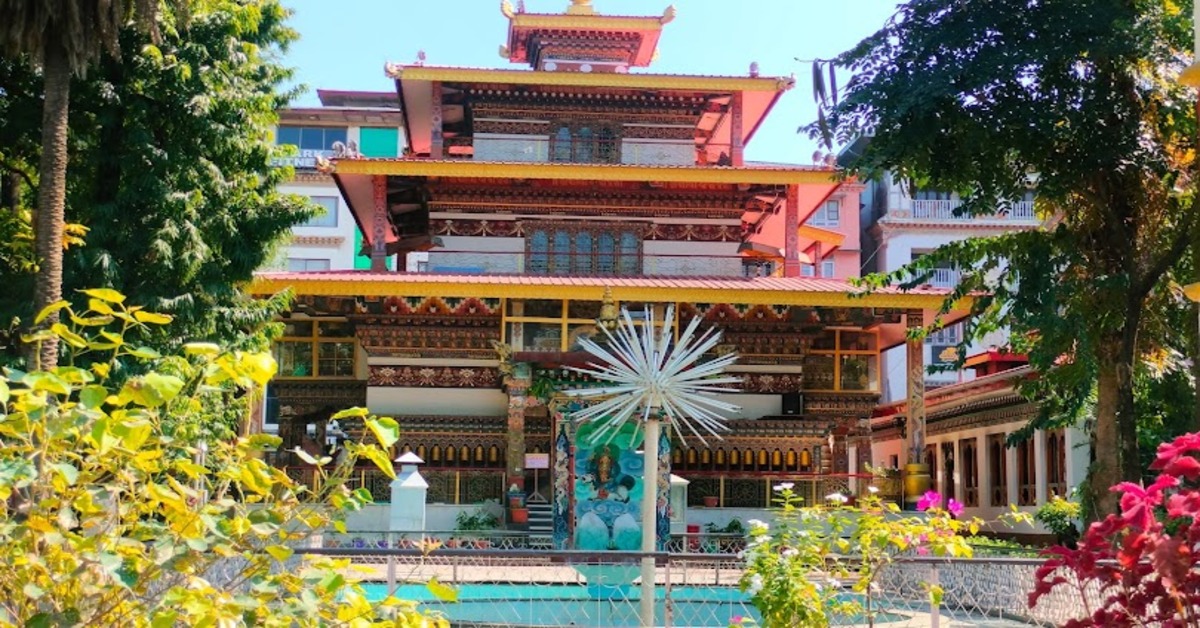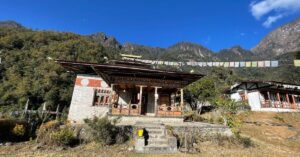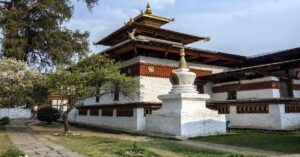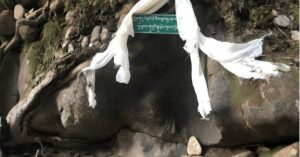Zangdo Pelri Lhakhang in Phuentsholing is a small monastery representing the “celestial abode of Guru Rimpoche” built in the 1900s by Dasho Aku Tongmi. The temple is located in the middle of Phuentsholing town, just a few steps from the Bhutan-India border gate, enclosed by a recreational park.
Zangto Pelri Lhakhang Phuentsholing is one of the most popular tourist destinations in Phuentsholing Gewog under Chhukha Dzongkhag. This three-story monastery, which features exquisite ancient Bhutanese architecture, is well-known for its eye-catching statues and intriguing murals. The Lhakhang has become one of the best pilgrimage sites and a popular tourist attraction in Phuentsholing among Indian tourists.
Zangdopelri, meaning “Copper-Colored Mountain” or “Copper-Coloured Celestial Abode,” is the pure land or paradise of Guru Padmasambhava. It’s often depicted as a three-tiered palace on a mountain, where Guru Rinpoche is revered, and considered a place of enlightenment and liberation.
How to Reach Zangto Pelri Lhakhang, Phuentsholing
Zangto Pelri Lhakhang is in the heart of Phuentsholing town, near the Bhutan Immigration Office, offering peace and solace. Phuentsholing is the border town of Bhutan and India. From India, the only way to reach Zangto Pelri Lhakhang is via road. The Nearest Airport is Bagdogra Airport, and the Nearest Railhead is the Hasimara Railway Station. You will get several taxis or autos for hire to reach Jaigaon, the border town of India. The temple is open from 8 a.m. to 6 p.m. and has no entrance fee.
Sacred Relics to See at Zangdo Pelri Lhakhang
- Statue of Buddha Amitabha;
- Statue of Guru Rinpoche;
- Eight manifestations of Guru Rinpoche;
- Statues of Bodhisattvas;
- Statue of Avalokiteshvara;
- Statue of Zhabdrung Ngawang Namgyal;
- An elephant skull in a box.
Also Read: Guru Rinpoche in Bhutan: His Visits to Bhutan and Sacred Sites
Historical Significance of Zangdo Pelri Lhakhang
Zangdo Pelri Lhakhang in Phuentsholing, also known as the ‘Paradise of Guru Rinpoche’, is a site of great historical significance in Bhutan. It is said that an elephant skull was uncovered while digging the foundations for the construction of the older Mani Dungkhor Lhakhang. The skull can still be seen between the old and the modern Lhakhang, housed in a box.
Later, Dasho Aku Tongmi, a music composer of the National Anthem of Bhutan, built a modern Zangto Pelri Lhakhang in the 1900s. The Monastery was constructed to represent the celestial paradise of Guru Padmasambhava.
Also Read: Kharbandi Monastery, a Temple on the Precious Hill in Phuentsholing
Description of Phuentsholing Zangto Pelri Lhakhang
Zangto Pelri monastery is in the center of Phuentsholing city. The monastery is always abuzz with activity, with both locals and tourists doing the circumambulation and spinning the prayer wheels.
When you visit Zangto Pelri Lhakhang, respect the religious practices and culture by dressing conservatively and following the local traditions. The Lhakhang is not just a tourist site but also a place of deep spiritual importance to Bhutan. Circumambulate the temple or any other religious artifacts in a clockwise direction.
As you enter, the entrance is beautified by flower gardens and a nice park up front, with a huge ball fountain and a small pond. There are many miniature wheels around the temple and giant prayer wheels behind it, where visitors spin and circumambulate while they relax and soak in the spiritual vibes.
Zangto Pelri Lhakhang is a three-storied complex structure with splendid exteriors and equally marvelous interiors, with walls and ceilings adorned with colorful frescoes and murals. Considered one of the tallest Zangdo Pelri Lhakhangs in the country, it houses life-size statues of eight manifestations of Guru Rinpoche and other Bodhisattvas. The main statue of Zangto Pelri Lhakhang in Phuentsholing is Buddha Amitabha (Sangay Yuepamey) on the top floor of the monastery.
On the second floor, the shrine houses statues of Zhabdrung Ngawang Namgyal, Chenrezig, and the eight Bodhisattvas. A four-meter-tall statue of Ugyen Guru Rinpoche flanked by his eight manifestations is on the ground floor. The walls have paintings depicting the life of Lord Buddha. You can take part in lighting butter lamps and observing the daily rituals and prayers here.
Best Time to Visit Phuentsholing Zangdo Pelri Lhakhang
The best time to visit Phuentsholing is from November to April. You can visit the Zangto Pelri Lhakhang any time between 8 AM and 6 PM. However, the park is open till 10 PM. Visit to relax and soak in the spiritual vibes in the evening, as a fountain lights up the monastery and its vicinity. You can visit the major pilgrimage sites of Phuentsholing, Chhukha with the Bhutan Pilgrimage Package.
Sacred Places to Explore in Chhukha
Dokhachu Goenpa: Also known as Chapcha Dargay Choeling Goenzin Dratshang, is an Ekajati Lhakhang in Bhutan near a boulder cave pointing to the sky. It is located in Chapcha Gewog under Chukha Dzongkhag at an elevation of 3048m overlooking the village of Rin Thangkha. Lama Choeje Thinley Jamtsho, a grandson of Phajo Drugom Zhigpo, founded Dokhachu Goenpa in 1650.
Tumdra Ami Ney: This sacred site is the chief abode of the wish-granting goddess Lhamo Ekajati, located in Darla Gewog under Chhukha Dzongkhag in Bhutan. The sacred site is said to have been visited and blessed by Guru Rinpoche in the 8th century. Later in the 15th century, Thangthong Gyalpo discovered the Tumdra Aminey. In the early 18th century, Terton Drukdra Dorji spent a few years meditating and discovering “Ters” from the Ney.
Kharbandi Monastery: Also known as Rinchending Goemba, it is a Buddhist monastery perched 400 meters above sea level on a precious hill of Rinchending below the Phuntsholing–Thimphu Highway. The Royal Grandmother, Ashi Phuntsho Choden, built the monastery in 1967.
Places to Explore in Phuentsholing
Phuentsholing, the second largest town in Bhutan, is a bustling border town that serves as an important economic hub and entry point for travelers from India. Phuentsholing blends traditional Bhutanese architecture with modern infrastructure. Here are some of the popular attractions in Phuentsholing:
Kharbandi Monastery: Also known as Rinchending Goenpa, it is a monastery near Phuentsholing that provides a tranquil spiritual escape.
Milarepa Lhakhang: Sangye Migyur Ling Monastery, also known as Mila Serkhar Guthog Lhakhang, is a nine-story replica of an 11th-century structure built by Milarepa in Tibet.
Bhutan Gate: A traditional Bhutanese gate that separates Bhutan from India, located in the Indo-Bhutan border town of Phuentsholing.
Palden Tashi Chholing Shedra: Dedicated to Buddhist education and spiritual learning, it is a Buddhist institute in Phuentsholing.
Phuentsholing Park: Phuentsholing Park is a popular destination in the town, with eucalyptus and sal trees, gazebos, a basketball court, and food stalls.
Amo Chhu Crocodile Breeding Centre: It is a wildlife conservation area dedicated to breeding and studying crocodiles. The center houses two species of crocodiles: gharials and muggers. Tourists can visit the center from 9 am to 5 pm.
Phuentsholing Vegetable Market: An integrated vegetable market designed to offer fresh produce in a more appealing environment for customers.
Amochu Suspension (Hanging) Bridge in Phuentsholing: Also known as the Hanging Bridge is one of the tourist attractions in Phuentsholing.
Enjoyed reading this blog?




